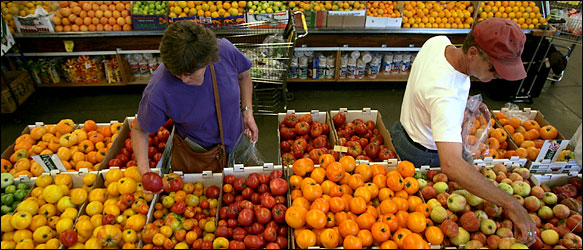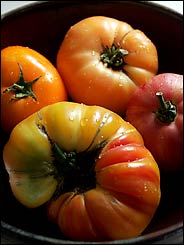
BERKELEY, Calif.
THE Berkeley Bowl Marketplace stirs up the worst kind of tomato lust.
You can't help it. The sun is beating down outside like some kind of Provenšal demon and here amid the sawdust-strewn aisles of this bland, low-lying store, there are 20 - 20! - varieties of heirloom tomatoes stacked, strewn and otherwise arrayed, taunting you, the defenseless shopper.
Come hither. For $2.49 a pound.
And if it only ended there. There are also at least 20 kinds of regular old tomatoes; Early Girls that are smooth and taut and round; Odorikos, with their pinkish - or is it fuchsia - glow. Pale green ones are ready to bread and fry at 99 cents a pound. I picked up a Brentwood Large tomato and weighed it: it was a pound and a quarter.
Here at the Berkeley Bowl, there are 10 different types of cherry tomatoes alone: tear-shaped Santa grapes, pesticide-free Sweet 100's, red cherry, mixed medley. Like all the produce, each is identified in scrawled red ink on a plain sheet of white paper, folded over a wire strung above the bins.
The store boasts the largest produce section in Northern California all year-round, but in July and August it becomes a jaw-slackening, pulse-quickening bazaar for tomatoes of every imaginable kind.
As I stood there overwhelmed, a woman grabbed my arm.
"Wait!" she urged. "You've got to smell these." She pulled a bag of Odorikos from her cart and shoved them under my nose. Her eyes widened, her eyebrows jutted upward. "Right?" She pointed a finger across the aisle to where she had found them.

Such passion is not uncommon at the Berkeley Bowl, where the carts bang into one another in the narrow byways, even on a weekday afternoon. And this, I was assured, was a particularly calm hour.
"You have to be in a Zen mind-set when you come here," said Barbara Manierra, a college adviser, pausing over some waxy yellow heirloom varietals, Lemon Boys. "This is empty. You have to be very calm, and not in a rush. It can be a very intense experience - there's so much choice, and it gets very crowded."
And because of its high quality and bargain prices, the Berkeley Bowl has an equal opportunity vibe. On this particular day, a yuppie in a polo shirt shopped beside a guy with dreadlocks, and a college student squeezed past a baby boomer in a tie-dyed T-shirt and a family speaking Spanish.
Nancy Swearengen, a white-haired resident of nearby Montclair, said she comes here every week "whether I need to or not - just to breathe it in."
"It's not just the 16 kinds of tomatoes, it's the vitality, the diversity," she explained. "I pick up good recipes. The whole nine yards."
Glenn Yasuda opened the Berkeley Bowl in 1977 in a former bowling alley just down the street. At the time he was teaching business education at a local college, but had put himself through school by hauling produce at a wholesale market in Oakland. He was entering the organic produce business at just the right time (not everything is organic, but he says he tries), and has been so successful that in 1999 he moved into this converted Safeway supermarket. He is in the process of securing permits for a second store in southwest Berkeley.
But Mr. Yasuda, 71, is almost impossible to find because he spends five or six days a week at the local wholesale markets, overseeing purchases. When I finally caught up with him by telephone, Mr. Yasuda said he had two workers in his office who needed his attention and he really had to go. Pressed to comment on what makes his store unique, he said: "I don't know. All the markets are pretty good. We do the same thing."
Reminded that his customers seem to think the Bowl is rather special, Mr. Yasuda made an effort. "I think it's everything," he said. "Not just produce. Our grocery section, we have a lot of variety, we do a good job."
And off he went to check the contents of the latest load.
Mr. Yasuda can let his tomatoes speak for themselves. After buying nine pounds of tomatoes for $21.81, I sat down in a friend's kitchen to discover the textures and flavors of each (or as many as I could manage).
The Pink Zebra looked like a cross between a Fuji apple and a peach; it was sweet, not acidic, with deep pink flesh inside. The Cherokee Purple was deep vermilion with dark green streaks on the outside. Cut open, it looked like a hunk of raw meat, with firm flesh and little juice. The Lemon Boy was pale on the inside, tart and less intense than the others. The Beefmaster looked like a gnarly pincushion on the outside; inside it had deep red flesh and burst with flavor.
I also tried the Wilgenberg hothouse, the Miyashita Nursery, the Momotaro, Big Beef, Dr. Wych's Yellow, Zebras (striped bright lime on the outside, kiwi-colored on the inside), Pineapple Stripe (squat and small), Mountain Delight (orange shaped and deep yellow in color) and the plum-colored Black Prince.
Whew.
My favorite turned out to be the Red Brandywine, a huge, pumpkin-shaped tomato that was soft and red on the inside. It had a velvety feel and flavor, and was enough to quell the most serious tomato lust. At least until next summer.
